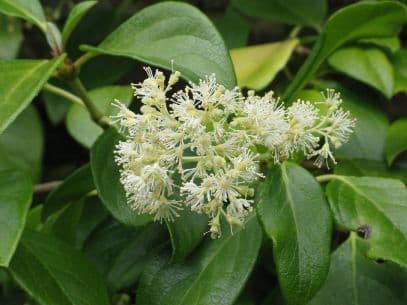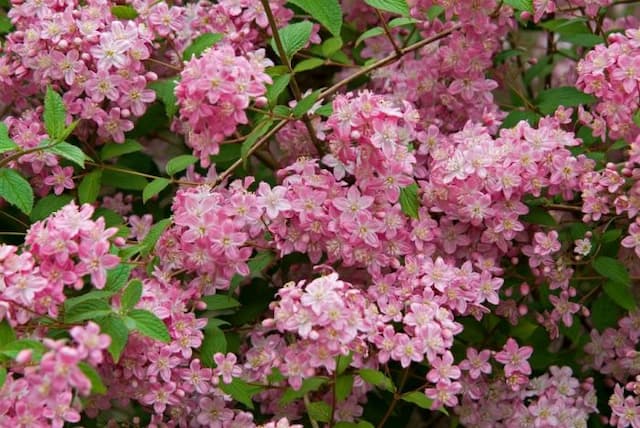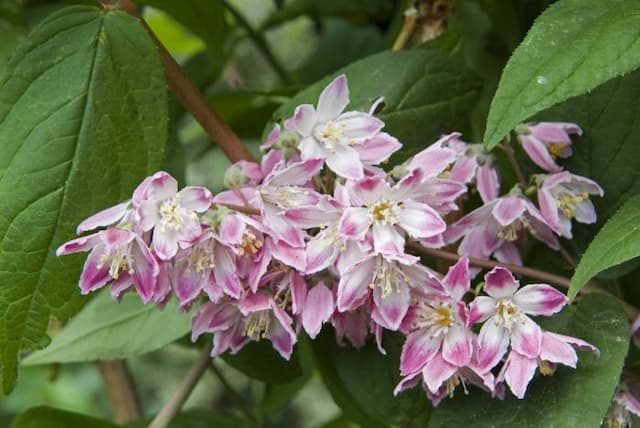Slender Deutzia Deutzia gracilis

ABOUT
Deutzia gracilis, commonly known as Slender Deutzia, is a deciduous shrub known for its elegant and graceful appearance. It possesses a fountain-like structure composed of numerous slender branches that gently arch outward. The plant is covered with deep green, lance-shaped leaves that are neatly arranged in opposite pairs along the stems. Come spring, Slender Deutzia becomes a spectacle of bloom, adorned with clusters of small, star-shaped flowers. These delicate blossoms are typically white, sometimes with a hint of pink, and they exude a subtle, pleasing fragrance. The blooms densely pack the branches, creating a fluffy and bountiful floral display that can cover the shrub from top to bottom. After the flowering season, the plant's foliage continues to add interest to the garden with leaves that turn to lovely shades before falling as the cooler temperatures of autumn arrive. The bark on the older stems gently peels, giving the Slender Deutzia an attractive and textured appearance even in the absence of leaves. As a garden plant, its charming presence and abundant flowering make it a popular choice for inclusion in mixed borders, as a specimen, or planted en masse for a dramatic effect. Overall, Slender Deutzia is praised for its simple beauty and ease of care, making it a beloved addition to both formal and informal garden settings.
About this plant
 Names
NamesFamily
Hydrangeaceae
Synonyms
Slender Deutzia, Graceful Deutzia
Common names
Deutzia crenata f. alba, Deutzia crenata var. gracilis, Deutzia crenata f. rosea, Deutzia gracilis f. albo-rosea, Deutzia gracilis f. rosea, Deutzia gracilis var. nana.
 Toxicity
ToxicityTo humans
Deutzia gracilis, more commonly known as Slender Deutzia, is not known to be toxic to humans. There are no well-documented symptoms of poisoning from ingestion of this plant. It is generally considered safe in terms of toxicology for human interaction and ingestion.
To pets
Slender Deutzia is also not recognized as a toxic plant to pets. While it is always best to prevent pets from ingesting plants, there are no specific symptoms of poisoning associated with this plant. If a pet does ingest parts of the Slender Deutzia, it is unlikely to cause significant toxicological consequences, but monitoring for any signs of distress and consulting a veterinarian is advisable.
 Characteristics
CharacteristicsLife cycle
Perennials
Foliage type
Deciduous
Color of leaves
Green
Flower color
White
Height
2-4 feet (0.6-1.2 meters)
Spread
2-4 feet (0.6-1.2 meters)
Plant type
Shrub
Hardiness zones
5
Native area
Japan
Benefits
 General Benefits
General Benefits- Ornamental Appeal: Produces clusters of beautiful, small white flowers that enhance aesthetic value to gardens and landscapes.
- Wildlife Attraction: The blooms attract pollinators such as bees, which are beneficial for fostering a healthy ecosystem.
- Low Maintenance: Known for being relatively easy to grow and care for, requiring minimal pruning and upkeep.
- Seasonal Interest: Provides seasonal interest in spring when it blooms, adding to the variety and charm of a garden space throughout the year.
- Compact Size: Its small size makes it a suitable choice for smaller gardens or as part of mixed borders and ornamental arrangements.
- Adaptability: Can adapt to a variety of soil types, although it prefers well-drained conditions.
- Hardiness: Quite hardy and can withstand cold temperatures, making it suitable for a variety of climates.
 Medical Properties
Medical PropertiesThis plant is not used for medical purposes.
 Air-purifying Qualities
Air-purifying QualitiesThis plant is not specifically known for air purifying qualities.
 Other Uses
Other Uses- Slender deutzia can be used in bonsai cultivation for its delicate foliage and attractive flowers.
- With its dense growth, slender deutzia can serve as a habitat for beneficial insects and small wildlife in a garden setting.
- When planted in mass arrangements, slender deutzia provides soil stabilization on slopes and banks, reducing erosion.
- Its woody stems can be used in decorative crafts, such as wreath making and floral arrangements after flowering.
- Slender deutzia can be planted in urban environments as a street-side ornamental due to its compact size and resilience to pruning.
- Though not commonly consumed, the petals of slender deutzia are edible and can be used as a garnish for salads and desserts.
- The plant can be utilized in sensory gardens thanks to its fragrant blooms catering to the sense of smell.
- Slender deutzia wood, while not a prime timber source, can be harvested for small-scale woodworking projects or as specialty kindling.
- In educational settings, slender deutzia can be used to teach about plant lifecycle, pollination, and seasonal changes due to its distinct flowering period.
- When dried, slender deutzia branches can be used to create naturalistic indoor decor items, such as wall hangings or centerpieces.
Interesting Facts
 Feng Shui
Feng ShuiThe Deutzia is not used in Feng Shui practice.
 Zodiac Sign Compitability
Zodiac Sign CompitabilityThe Deutzia is not used in astrology practice.
 Plant Symbolism
Plant Symbolism- Innocence: The pure white flowers of the Slender Deutzia are often associated with innocence and purity.
- Humility: Its unassuming nature and delicate blooms signify humility, modesty, and the simplicity of beauty.
- Patience: As the plant takes time to flourish and bloom, it symbolizes patience and the rewards of waiting.
- Transient Beauty: The brief blooming period of the Slender Deutzia signifies the fleeting nature of beauty and life's ephemeral moments.
- New Beginnings: The appearance of its flowers in spring suggests renewal, making it a symbol of fresh starts and new ventures.
 Water
WaterSlender Deutzia requires moderate watering, and it's best to water the plant when the top inch of the soil feels dry to the touch. Typically, watering once a week with about one to two gallons of water will suffice, but this may vary with environmental conditions. During the growing season in spring and summer, you may need to water more frequently, while in winter, watering should be reduced. Ensure that the soil is well-drained and avoid waterlogging as this can lead to root rot.
 Light
LightSlender Deutzia thrives in full sun to partial shade conditions. The ideal spot for this plant would be one where it can get at least six hours of sunlight daily, although it can tolerate some afternoon shade. Avoid deep shade as it can lead to poor blooming and leggy growth.
 Temperature
TemperatureSlender Deutzia is hardy and can tolerate a temperature range from about 20°F to 75°F, making it suitable for USDA hardiness zones 5 through 8. The ideal growing temperatures for this plant are between 60°F and 70°F. It's essential to protect the plant from extreme cold and frost which can damage the foliage and blooms.
 Pruning
PruningPruning is important for Slender Deutzia as it encourages fresh growth and maintains the plant's shape. Pruning should be done immediately after the flowers fade in late spring or early summer. Cut back up to one-third of the old wood to ground level and shape the remaining branches as desired. This also helps rejuvenate the plant and ensures prolific blooming for the next season.
 Cleaning
CleaningAs needed
 Soil
SoilSlender Deutzia thrives in well-draining, loamy soil enriched with organic matter; ideal pH is slightly acidic to neutral, between 6.0 and 7.5. For the best soil mix, combine two parts garden soil, one part peat moss or compost, and one part perlite or coarse sand to enhance drainage.
 Repotting
RepottingSlender Deutzia should be repotted every 2-3 years or when the plant has outgrown its current container, ensuring a slightly larger pot each time to accommodate root growth.
 Humidity & Misting
Humidity & MistingSlender Deutzia prefers average room humidity levels and does not require high humidity, making it suitable for typical home environments.
 Suitable locations
Suitable locationsIndoor
Provide bright light, well-draining soil, and regular watering for indoor Slender Deutzia.
Outdoor
Plant in well-draining soil, partial sun, and shelter from harsh elements for outdoor Slender Deutzia.
Hardiness zone
5-8 USDA.
 Life cycle
Life cycleDeutzia gracilis, commonly known as Slender deutzia, begins its life cycle as a seed, often requiring a period of cold stratification to break dormancy and germinate effectively. Upon germination, the seedling emerges and grows into a young plant, developing a root system and foliage through the vegetative growth stage. As the plant matures, it enters the flowering stage typically in late spring, producing clusters of small, fragrant white flowers that attract pollinators. After pollination, the flowers develop into fruit capsules which eventually release seeds, completing the reproductive cycle. Once the plant reaches maturity, it can live for several years, flowering annually. Over time, the Slender deutzia may become woody and require pruning to rejuvenate growth and maintain a desirable shape.
 Propogation
PropogationPropogation time
Spring-Early Summer
Deutzia gracilis, commonly known as Slender Deutzia, is typically propagated during the late winter or early spring before new growth starts. The most popular method of propagation for Slender Deutzia is by softwood cuttings. This involves taking a cutting of new growth that is not yet mature, usually about 4 to 6 inches (10-15 cm) long. The leaves on the lower half of the cutting should be removed, and the cut end should be dipped in rooting hormone to encourage root development. The prepared cutting is then placed in a moist potting mix, with the bottom half of the cutting buried in the soil. The cutting should be kept under high humidity by covering with a plastic bag or placing in a propagator and kept in indirect light. Roots typically develop within a few weeks, after which the new plant can be transplanted into a larger pot or into the garden.





![Rose deutzia [Yuki Cherry Blossom]](/_next/image?url=https%3A%2F%2Fplants-admin.emdemapps.com%2Fimages%2Fplants%2F%2Fimages%2F604b6510a383a.png&w=640&q=75)


![Hydrangea [Hot Chocolate]](/_next/image?url=https%3A%2F%2Fplants-admin.emdemapps.com%2Fimages%2Fplants%2F%2Fimages%2F604b5a066e3bd.png&w=640&q=75)
